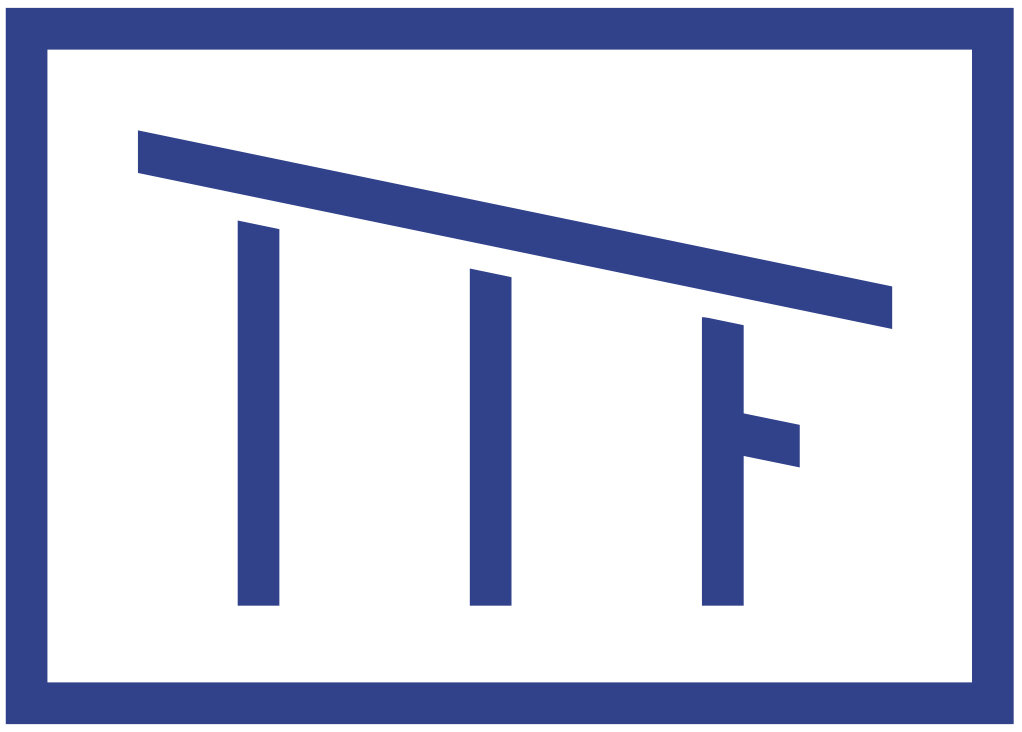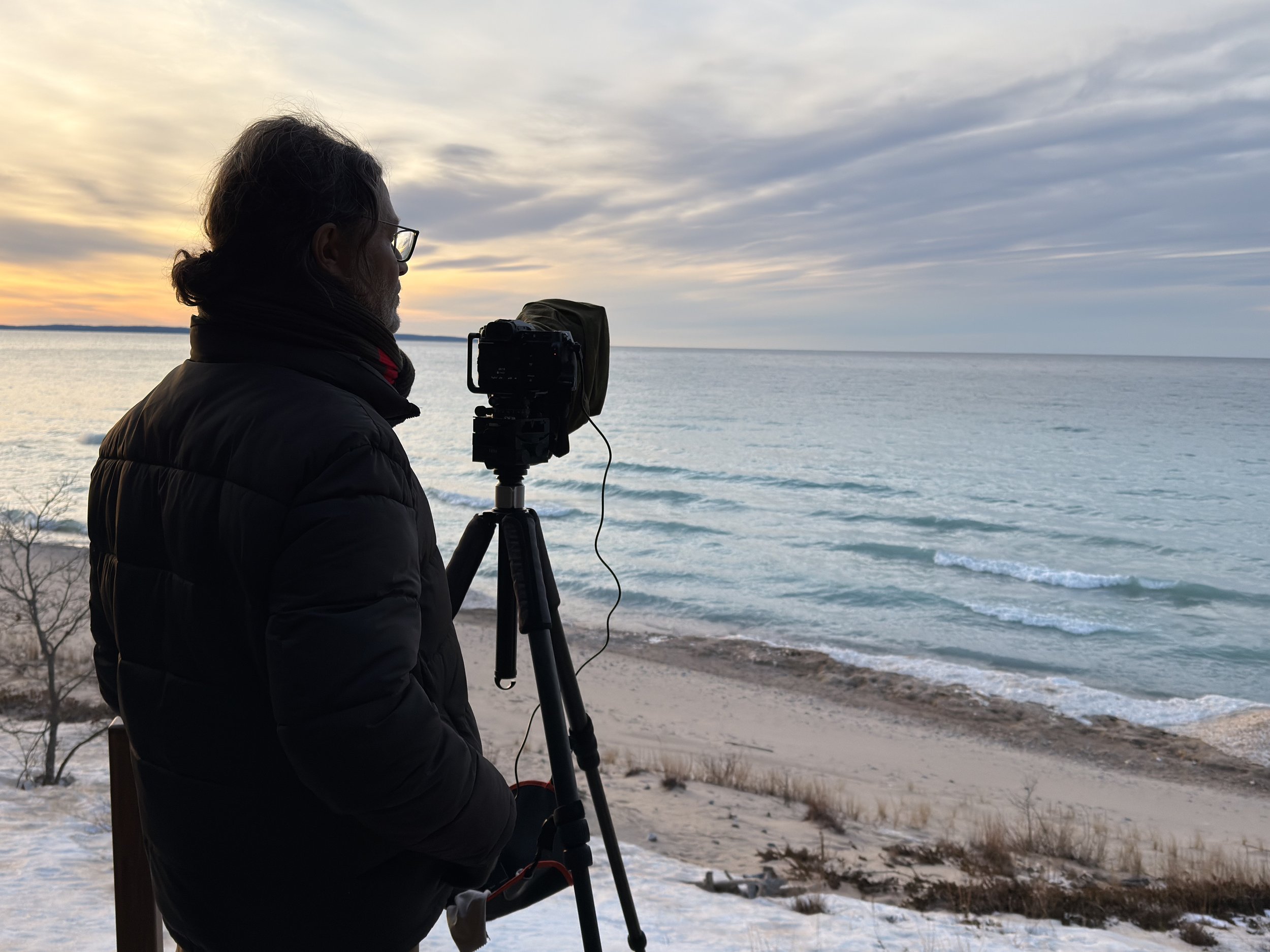‘Surveying Time’ with Alon Koppel
An interview conducted by Director Geoffrey Peckham with artist-in-residence Alon Koppel. Edited for clarity.
Alon Koppel (AK): I made this grid of 9, in 22 x 17”. I personally really like the grids, I love this one (left). People say it’s like a Rothko, very silvery and blue. It’s not immediately clear what’s going on.
Geoffrey Peckham (GP): Emotionally or subject-matter-wise?
AK: I think both. It’s interesting, I’ve been posting every day on Instagram… people are really responding to them, relief from what’s going on politically and in life. It’s encouraging because, for me, some of them are a little too pretty. But it’s on the border of the sublime, which I’m more interested in. Here, 21 strips—these are chronological–you can see more ice on the left. So those start with photographing the landscape, as it is, and then saying, ‘What else can we do with that to make it a series of photos?’
I think for me, I do always feel like I should break from the single photo landscape. My eyes are trained on landscape, but my eyes are also trained on the landscape that humanity has changed. So these are not exactly that, but it's about nature changing through three weeks. I'm thinking that, as a title for it, I should look at all the files and add up all the time that it took. A 15 minute [exposure], an hour, 30 minutes. How many hours is this one single piece of paper?
GP: And over? How much time? Over 28 days?
AK: Right, exactly. So I would like to be more accurate about it. And I think that would be lovely—I wouldn't say scientific, because I'm not a scientist but an observer, a surveyor of the nature of landscape.
GP: You know, I like that aspect. You'll notice it with Frank Gohlke’s photographs of Mount St. Helens. That might be a title for a book of yours: Surveyor of Time. Because people survey land, they survey parking lots, right? You survey time and light.
AK: Yes, that's a nice way to say it, Geoffrey. And I'm really excited about it, coming back to photographing after 20 in graphic design, with the renewed energy to do the work and keep exploring… I did another diptych here in black and white. With this one, I was [thinking to print in] photogravure, but I liked the tones of this print.
GP: In a way, the Piezography allows for incredible tonal gradations, but it also allows for dialing in on the actual color of the image. Because it’s not black and white, it’s brown and black and white and blue. Those are beautiful. Especially because the ice ties them together—with the ice and without the ice on a 15-minute exposure.
AK: Yes, the one on the left is 15 for sure, the one on the right might be 30. This one is one of the first nights when I arrived. I printed this photo (left) from Catskill of the train [in photogravure].
GP: How do you feel about them?
AK: I think this one worked out well. The tonality really excited me—using an older technique on something that is about modern transportation. That’s the Amazon logo here (on the train, top right)… Just the whole interaction with the [press] is lovely. You come in for a day, you prepare the plates and the paper the day before, and a day later I press it. I got into the rhythm.
GP: Yes, that’s what it is. I know how much Vaune Trachtman worked to be able to produce five images each of 10 images. Just how much time it takes to ink a plate, wipe it, and get the edges clean. And preparing everything ahead of time, like you’ve just described. It’s a phenomenally time-consuming process and the end result is something that looks ancient in comparison. You really have to be devoted to the process and feel like it’s giving you the image content that you want. I’m not sure I’m there, personally, for my own work, I’m more interested in other aspects of it. But it’s fun to try it.
AK: It’s definitely fun to try and this gave me what I wanted to see. I made these smaller prints too, and this accordion.
GP: Is it chronological too?
AK: Yes, this is for the most part chronological. It goes from ice to slightly ice, and then almost no ice…
GP: I’m really pleased to see the facilities used so well. Really, it’s a joy. That work is beautiful. And, yes, you have to be afraid of making calendar pictures, something that is too beautiful, but incorporating beauty into your work is nothing to be afraid of.
AK: Thank you. The joy that you described is very heartfelt. I enjoyed every moment, from morning to evening, thinking about photography, going out to make pictures, coming back, thinking about it, looking at the books, printing it, mounting it. This is really what I wanted to do. It exceeded my expectations, in a way, because of the snow and access to a Lake that is changing. I didn’t realize the snow would be such a nice part, a third of the photo. That gives it another dimension… I’m ok with ‘pretty,’ because I think we need to push it to a level where there is pretty but, what else can we do with it? I think it has to go to pretty and sublime and see what can be extracted from it.
GP: In fact, the very first question I had was that so much of your work has an aspect of time to it. I wanted to ask you how the place and the landscape there during this period was put to use. You just described it with the snow, the unexpected element, being an indicator. Do you want to elaborate on that?
AK: I think with the landscape, I had in mind to find an interesting tree that overlooks the Lake [to] photograph every day. But, you have to be aware not to get into tunnel vision. So when I saw the Lake with the snow, I thought ‘This is it, the shapes are beautiful, the light is beautiful, let’s just go with that.’ There is a trusting of the process. And the snow really added to it… Now we have time, we have global warming, we have climate change, on a minute-scale but, this is March, and some days here were in the 50s/60s.
GP: That ice, it snows on top of it, it melts, it turns into blowholes…
AK: I love all the shapes, very sculptural. I would go there every day and the sculptures kept changing. Nature gave me this gift of photographing time. And then with the birds, I don't know how to connect it yet, but I don't necessarily need to. I think about it serially, even if it's not going to be a book, it just helps me connect the ideas in my mind. I do feel there's an impact here of showing people beautiful-beautiful-beautiful-and then ‘life.’ Reality bites—that's also time.
GP: It's also time. I was thinking exactly the same thing… It does give you a sense of life and death.
AK: The Lake is so big that when you look at the horizon, it's infinite. But it also gives us a space in the world to be… you feel alive. The power of nature is encompassing. And then you walk down to the beach, and the macro of the beautiful world changes to micro and you see death, it’s just more apparent now with Avian flu.
GP: In terms of aloneness, you were there alone for quite a while. How do you think being alone with it, with your work, with the landscape, with the place—how did it feel, and what do you think you accomplished with that aloneness?
AK: Yes, a good question. I really appreciate that time on my own, and being alone is what I like as a photographer… I would spend a week here and I would not see anybody. What you set up here is so special. You go out and photograph in this amazing experience, on this beautiful lake, and then you go back to this amazing home that is so beautifully detailed. The whole experience allows you to concentrate on the work. It allowed me as a person, as an artist, to be really immersed. If the light is good, I would immediately go photograph. Or if it was cloudy or I was tired, I would read books in the library and immerse myself in books that I only knew of. You have such a beautiful collection.
GP: Any one or two stand out for you?
AK: I really like Victoria Sambunaris. We both follow each other on Instagram, so when I saw her book, I went through it very carefully and read the whole essay by Natasha Egan... The books, the essays, reading, taking notes, just the time for myself—I never had anything like that. I don't mind being on my own, and again, the place provides such comfort in the solitude. All the details, the door handles, the architecture, the light coming in the bedroom in the morning that gets you out of bed… And the view outside from the back is gorgeous.
GP: I think that’s why Amanda Acker painted it, that scene in the fall.
AK: I love being in sync with nature—getting up early in the morning to shoot first light, and then staying up later for last light.
GP: Where do you think you’re going from here? You played with the sculptural aspect, taking [the work] from two dimensions and into three, but are there other things that you’d like to explore?
AK: I think more seascapes in different places. Continuing the series over the Pacific, over the Atlantic, in Israel—doing this series of long exposure and seeing what the light does to those places.
GP: You know Sugimoto’s work, right? In a way, the ice [situates] your work into a specific place, rather than just being a long exposure of a horizon line. That having been said, I really like the ‘Rothko’ one.
AK: Right? I feel like the ‘Rothko’ one, it is a very specific light for Lake Michigan... And, I look at the grid of nine, it looks so different within three weeks of photos. I can't believe that it's the same place. To me, that's interesting. I can compress three weeks into what looks like a longer period of time.
GP: They're all at sunset?
AK: No, through any time of day. [In the] morning I shoot at least a few, and then in the afternoon, and evening before the sunset. During the full moon last week, I went out at midnight and did a four-minute exposure of The Passage. I don't have my big flashes or anything, but it came out. The light is spilling out into the forest, and the exterior is lit up because the moon was so strong… I enjoy the challenge of being in a place and photographing it for more than 24 hours, which is often [what you get on shoots].
And on the super cold days, I would sit inside The Passage. It was cold, but no wind and, while the camera was photographing, I would write my notes there and take photos… I love that cabin; although, it’s more than that.
Thank you for the opportunity again. A ‘thousand thanks’ from me. It's been very special.
GP: Well, I'm glad you've enjoyed the time and used it really well. And thank you for The Passage pictures. If nothing else, it's your interpretation of that place, the light that works with it, and you're the first one to do that. So, thank you.















